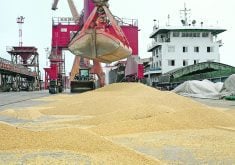Poor railway performance will result in Canada missing export targets for all the major crops, says an analyst.
Marlene Boersch, managing partner with Mercantile Consulting Venture, was bitterly disappointed with Statistics Canada’s February export numbers.
They show that Canada shipped 2.15 million tonnes of the nine commodities tracked by the agency. That is down 46 percent from the 3.96 million tonnes exported in January.
“They were an absolute catastrophe,” said Boersch.
However, it should be noted that there was a similar decline the previous February when exports dropped 37 percent compared to the January 2017 numbers.
Read Also

Flax sector sees omega-3 opportunity
SASKATOON — A global shortage of omega-3 oils could be an opportunity for the flax sector, says an industry official….
The export numbers include crops like wheat, barley and canola but they do not include pulses like peas and lentils, which are suffering steeper export declines than other crops due to India’s import tariffs.
“There is hardly a way we will hit any export targets for any of the major commodities, so that is a total flop,” said Boersch.
Neil Townsend, senior market analyst with FarmLink Marketing Solutions, agrees that the 2018-19 supply and disposition reports for many crops could be heavy due to bloated carryout numbers.
“The only two I’m not particularly concerned about would be canola and spring wheat,” he said.
Townsend believes those two crops still have a chance to meet export targets with a good late-season push.
Canola demand has been robust while a drought-reduced U.S. spring wheat crop has helped boost sales of Canadian spring wheat.
But most other crops will have burdensome carryout heading into the new crop year, especially peas, lentils and durum.
“Oh man, they don’t pencil out very nicely in 2018-19,” he said.
Townsend said this year’s dismal export program can’t be blamed solely on railway performance.
Government policy played a role with India’s import duties and Italy’s country-of-origin-labelling reducing demand for pulses and durum.
Townsend believes it will probably be 18 months or more before India is back in the market for pulses with forecasts for another average monsoon rain this summer in that country.
“If the Indians keep pulling off crops like they’re pulling off, as much as we laugh about it, they’re going to be self-sufficient for a while,” he said.
But there is something else behind the slumping exports that is more worrisome to Townsend than transportation and policy woes because it is more of a long-term threat.
“There’s very real, real, real, real signs that competition is increasing for a lot of crops that Canada used to have more or less market leadership on,” he said.
Black Sea countries pose a long-term threat to Canada’s exports. For instance, Kazakhstan is getting out of wheat and into producing crops like flax and lentils. Other countries in the region are also dramatically increasing pulse production.
Meanwhile, Russia and Ukraine are also ramping up wheat production and elbowing their way into markets like Indonesia, the world’s top wheat buyer and a market that used to be the domain of Canada, Australia and the United States.
It doesn’t help that China is spending US$1 trillion on the One Belt, One Road project. Construction is underway on the new Silk Road, which is designed to transform trade routes in Asia and make it easier for Black Sea countries to access markets like China and Southeast Asia.
















